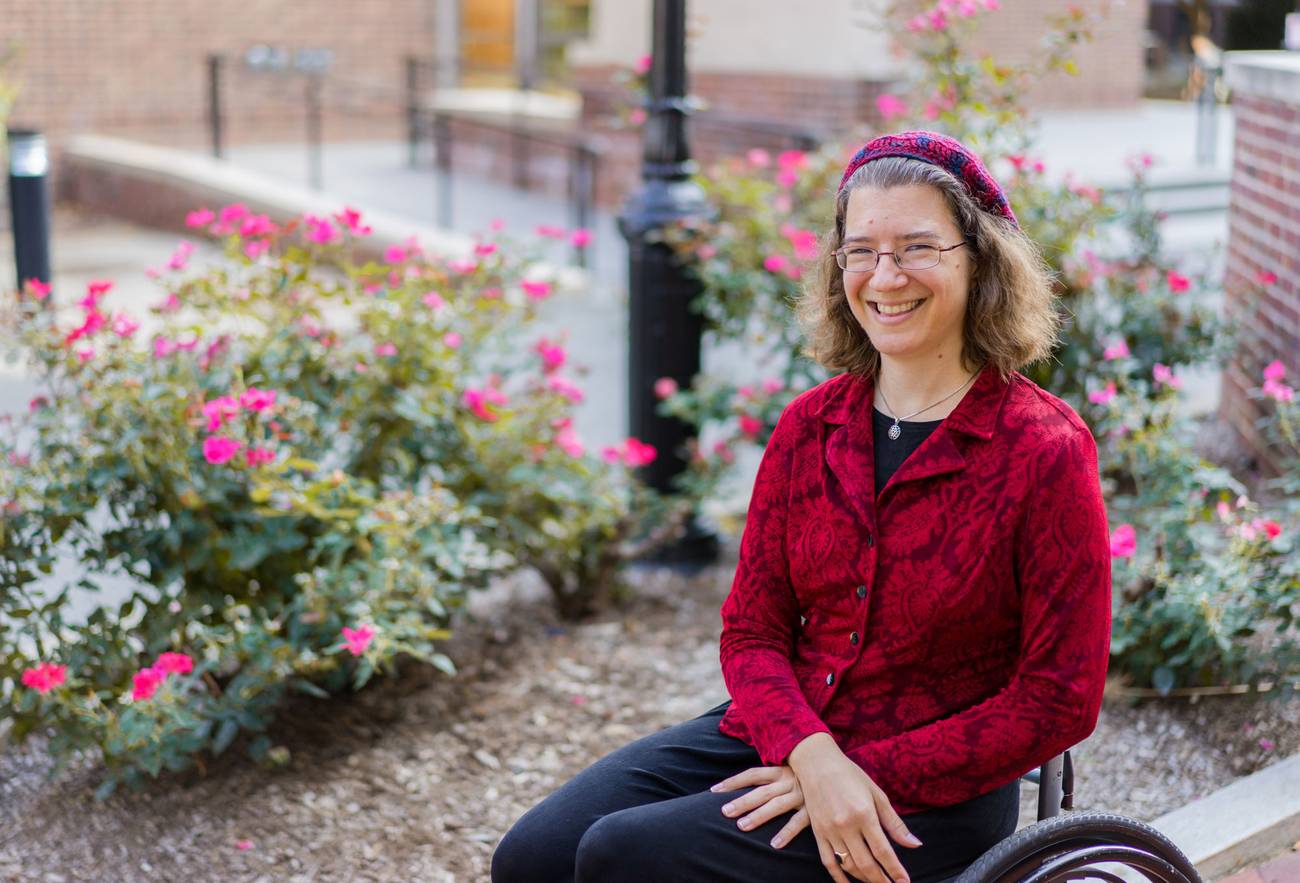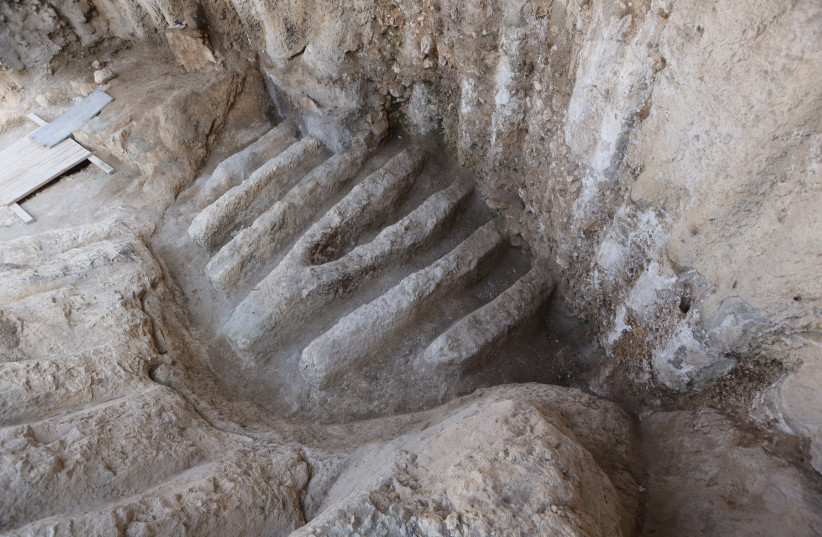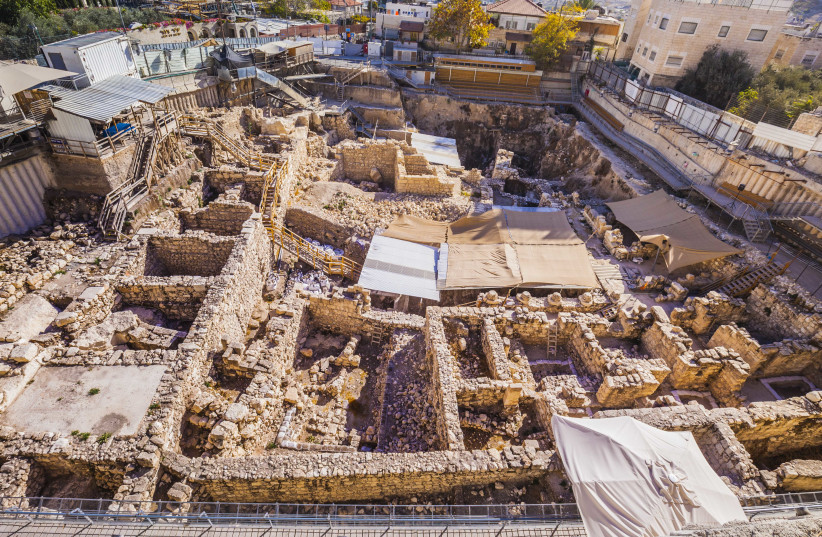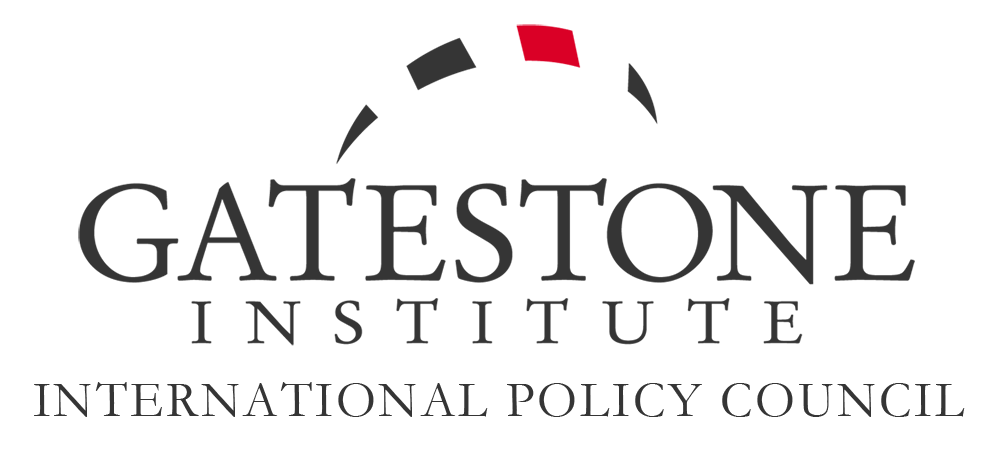 Reading Babel in Odessa During Wartime
Reading Babel in Odessa During Wartime
EDWARD SEROTTA
Part one of a series on Ukrainian Jewish writers.
.
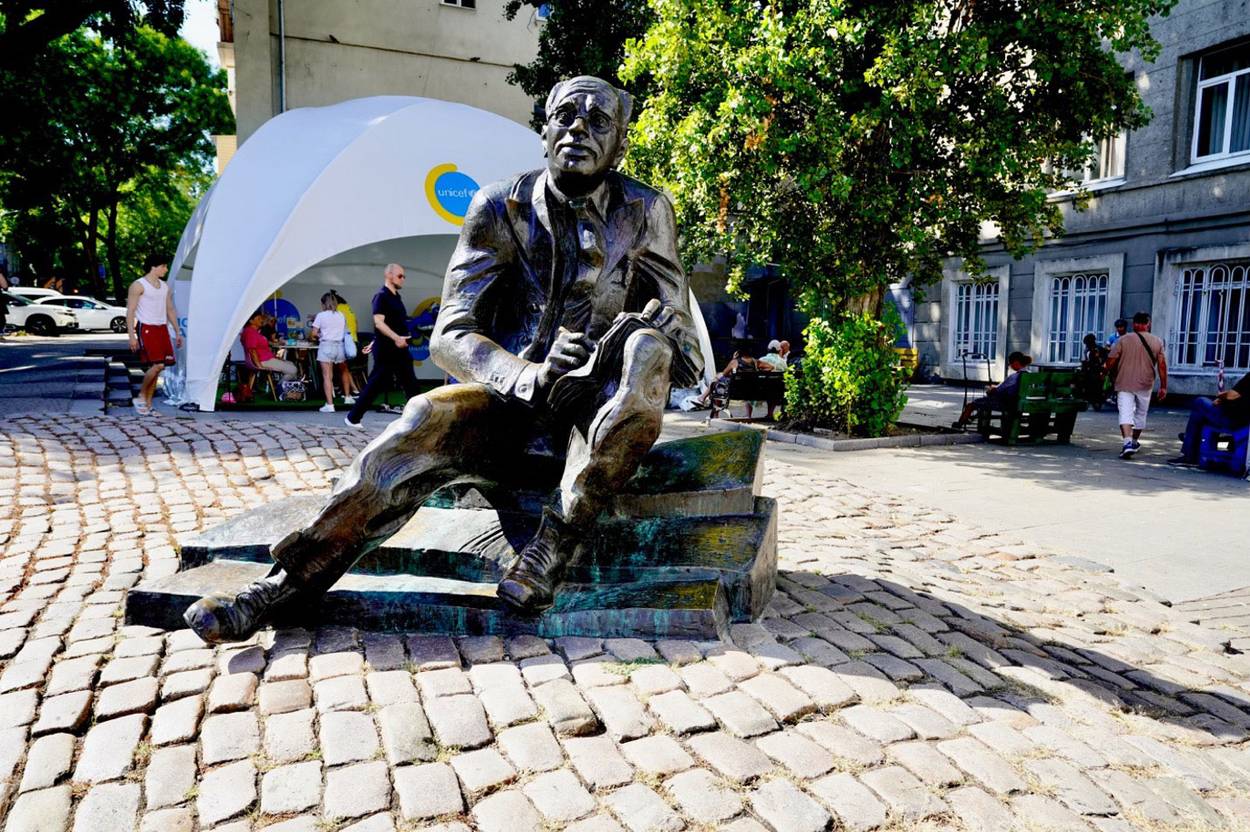 A statue of Isaac Babel in Odessa, near a humanitarian aid station for internally displaced refugees / COURTESY THE AUTHOR
A statue of Isaac Babel in Odessa, near a humanitarian aid station for internally displaced refugees / COURTESY THE AUTHOR
The problem with reading Isaac Babel’s Odessa Stories in Odessa is that once this master of pithy descriptions and colorful characters has painted a picture for you, you can’t unsee it. You just can’t look at people in bars and restaurants here and not imagine them as something out of Babel.
I’m not saying, of course, that this young and vibrant city doesn’t look like everywhere else in Europe, even during the ongoing full-scale Russian invasion of Ukraine, with teenage couples strolling along Deribasovskaya Street at night in black T-shirts, as interchangeable as Zara mannequins. But there I was in Kinka, one of Odessa’s most popular Georgian restaurants, rereading Boris Dralyuk’s brilliant translation of Odessa Stories while trying to flag down a waiter. That’s when I came upon a description of Benya Krik, Babel’s favorite Odessa gangster, who walked into a meeting wearing an orange suite and diamond cuffs.
I looked up to see two long-legged young women in tight black dresses slink into the booth next to me, and following them was a very tall, well-muscled man with a smartly trimmed beard, arms covered in tattoos, and he was sporting a single diamond earring. He was also dressed completely in white linen and the second he took his place, the waiter scurried over to take their order. Straight outta Babel, I thought.
Later that night, the news feed on my phone showed that Ihor Kolomoisky, one of Ukraine’s richest oligarchs, had just been detained the same evening on corruption charges. And what name did Kolomoisky like to use to describe himself? Benya. As in Benya Krik.
Fact does sometime follow fiction, but in Ukraine, facts matter. A few hours later, 25 Russian drones attacked Odessa, of which 23 were shot down, and two hit a storage depot south of town. The sirens wailed through the small hours of the night.
This all took place on the first day of a meandering trip through wartime Ukraine, my plan being to visit a half dozen cities (or more) where Jewish writers came from. Of course, considering the incredible number of Jewish men and women who were born and wrote in and about the cities of modern day Ukraine, I’m not going to get very far. Besides, it’s become really difficult to get a seat or bed on any train, and the buses are even more crowded.
I am beginning here in Odessa and am concentrating solely on Babel, even though Ze’ev Jabotinsky paints a nostalgic portrait of the city in his novel The Five (back when he called himself Vladimir). Sholem Aleichem did a bit of scribbling here, too. Contemporary poets like Ilya Kamininsky (now in the U.S. at Princeton) and Ludmila Khersonska, also have much to offer.
I have been to Odessa a half dozen times before, three of those visits in wartime. Although the 20th century had been brutal to her, this international port city still sports a mix of ethnicities and nationalities, although nothing like it once had. I’m told that around a third of the prewar population of 1 million fled when the full-scale invasion began last year, while families running from Mariupol, Kherson, and Mykolaiv have resettled in Odessa. Quite a few prewar Odessa families have also moved back. A teacher I know here, Natalia Handler, took her 9-year-old son to Germany in the early weeks of the war, “but he wasn’t making friends, he was going to school online in Ukrainian, and he really hated the food. He kept telling me every day, ‘I want my borscht!’ so we came back.”
The Jewish community may be small—no one could give me an exact figure—but they have two Jewish community centers and, of course, more than one synagogue. The Joint Distribution Committee is quite active, supporting food deliveries and running social programs for families and the elderly, as is Chabad. The Claims Conference sees to it that every Holocaust survivor is looked after.
Back at the turn of the last century, Babel claimed half of Odessa was Jewish, but it was actually around a third. Some 125,000 Jews lived here then although some statistics show upward of 140,000. The Holocaust, of course, decimated the Jewish population, and the Romanian army was every bit as murderous as the Germans when they entered the city in October 1941.By that time, Babel was already dead; he took a bullet to the head in a Moscow prison in January 1940.
Isaac Babel’s literary output is, compared to most writers, remarkably thin, on a similar scale as Bruno Schulz, though historian Richard Lourie calls Babel “arguably the greatest short story writer of the [20th] century.” His reputation rests on the 35 short pieces in Red Cavalry and the 13 in Odessa Stories. Both books were serialized throughout the 1920s and ’30s and both have been recently translated by the Odessa-born, Los Angeles-based Boris Dralyuk and published by Pushkin Press.
In Red Cavalry, the chubby, bespectacled Babel was embedded with Semyon Budyonny’s pro-Bolshevik Cossacks, who fought the Polish army in 1920 in today’s western Ukraine. It was clear the soldiers Babel accompanied were far more interested in looting, torturing, and killing than they were in anyone’s ideology. Jewish families were set upon to be raped and tortured—by all sides. At times, Babel was lucky enough to get away with his own life. Clearly, this was a man who enjoyed taking risks, or was addicted to risk.
Babel’s descriptions of wartime atrocities resonate today, especially when we read what Russians have done in Mariupol, Bucha, and other cities. Soldiers were just as insane in their brutality a century ago. In Red Cavalry, Babel does not spare us.
Budyonny hated Babel with a passion and did everything he could to have him arrested once he began publishing, but Babel was a protégé of the Soviet great Maxim Gorky, who advised Babel in his first ventures in journalism and stood up for him as long as he lived. Gorky died in 1936, but Babel was already well out of favor by then.
Odessa Stories is an altogether different book. “Odessa Stories is like a love letter to a time that vanished after the Revolution,” Igor Potocki, a 72-year-old poet and novelist told me as we sat in a café on Derebaska Street. “That world ended, but Babel kept it with him when he moved to Moscow. These were the stories that kept him coming back here, at least in his memory.”
To get a fuller picture of Babel, I went to see Olena Yavorska in Odessa’s Museum of Literature, just behind the ornate opera house.
With most of the museum’s windows boarded up and its exhibitions covered over, wrapped in plastic or removed, Olena met with me and my translator, Anastasia Herasymchuk, then ushered us into an office with masking tape X-ing out the windows and every surface covered with books, manuscripts, and piles of yellowed newspapers and dog-eared magazines. Olena moved a few books off of what might have been a chair and as I wedged into it, she took her place across from me, fired up her computer and turned a large monitor so it would face the two of us.
As Olena clicked on and enlarged documents and photographs, she began. “You could say that Babel was at two carnivals. There was the carnival of death, which is Red Cavalry, and the carnival of life, Odessa Stories.” She paused for a moment and said, like a proud Odessan, “I do have to say he exaggerated about the criminality here.”
Babel was born in Odessa in 1894. His father, Emmanuel, was a merchant who took the family to Nikyolaiv (Mykolaiv in Ukrainian) for a few years, then brought them back to Odessa, where he sold farming equipment. Olena pulled up one of his advertisements on her monitor.
Babel fell in love with Moldovanka, one of the poorest parts of town and where his grandmother lived. This would be the setting for part of Odessa Stories, while the rest of the book describes, fictionalized, his own growing up as a musically untalented lad who couldn’t swim or identify a single plant or flower. But he had a facility for memorizing things, and he loved going to school.
Here is how Babel describes those first school days: “We went from shop to shop buying my festive supplies—a pencil box, a piggybank, a satchel, new pasteboard-bound textbooks and notebooks in glossy wrappers. No one responds to the newness of new things like children. They shudder at the smell of them, like dogs on a hare’s trail, and experience a kind of madness that later, as adults, we come to call inspiration.”
Then there are the gangsters who come alive in Odessa Stories, and here is Benya Krik talking to someone’s mother, after he kills her son, “Aunt Pesya, if you want my life, you can have it, but everyone makes mistakes, even God. That’s what it was, aunt Pesya—a huge mistake. But wasn’t it a mistake on God’s part to put the Jews in Russia, where they suffer as if they’re in hell? I ask you, why not have the Jews live in Switzerland, with nothing but top-quality lakes, mountain air and Frenchmen as far as the eye can see? Everyone makes mistakes, even God.”
As Guardian book reviewer Nicholas Lezard wrote when he was reading Odessa Stories. “And with this, we’re hooked.”
Several reviewers have likened Babel’s Jewish gangsters to characters from a Tarantino film, but Boris Dralyuk reminds us that Babel was born the same year as Dashiell Hammett, whose tough guy characters speak a similar gangster lingo to Benya Krik, aka “the King.”
’Listen, Eichbaum,’ said the King, ‘when you die, I’ll bury you at the First Jewish Cemetery, right by the gates. I’ll put up a tombstone of pink marble, Eichbaum. I’ll make you an Elder of the Brodsky Synagogue. I’ll abandon my profession, Eichbaum, and we’ll partner up in business. We’ll have two hundred cows, Eichbaum. I’ll kill all the other dairymen. No thief will walk down the street where you live. I’ll build you a dacha by the beach, at the sixteenth tram stop … And remember, Eichbaum, you weren’t no rabbi in your youth either. Just between us, that will didn’t forge itself, did it? And you’ll have the King for a son.’
Olena told me that Babel became immensely popular with the reading public in the 1920s and ’30s. First, soldiers loved his dispatches, and throughout the 1920s he worked on bound editions of both Red Cavalry and Odessa Stories. He polished each story down to its nub, wasting not a word.
Babel, who only grew pudgier and balder as he aged, never stopped being attracted to women, and women loved him back. His first wife, Yevgenia Gronfein, left him because of his infidelities and moved to Belgium in 1925, although Babel continued to visit her and they had a daughter, Nathalie. His second wife was a Russian actress, and his third was an engineer in the Moscow subway system, Antonina Pirozhkova. They met in 1932 and lived together after 1934, although they never formally married. Their daughter Lidiya was born in 1937.
According to Pirozhkova, whose book, By His Side, is the closest thing we have to a Babel biography, Babel met NKVD chief Genrikh Yagoda in 1934 and asked him, “Tell me, how should someone act if he falls into your men’s paws?”
“Deny everything,” Yagoda said immediately. “Whatever the charges, just say no and keep saying no. If one denies everything, we are powerless.’’
Some advice. Yagoda, a genuine butcher, was arrested, tried, and shot in 1938. He was replaced by Nikolai Yezhov, who continued massacring hundreds of thousands of people and sending many more to the gulag. Yezhov’s wife, Evgenia, had known Babel before her marriage and, according to some, had an affair with him. Olena thinks not, but says they were friends.
As Yezhov’s star sputtered, and Stalin planned to have him tried and shot, Evgenia took poison in an asylum and died there in November 1938. Her husband was arrested in April 1939 and was tried and shot on Feb. 4, 1940. He was replaced by an equally monstrous killer, Lavrenty Beria, who managed to send hundreds of thousands more innocents to their deaths before taking a bullet in his own head shortly after Stalin died in 1953.
From Pirozhkova, we learn that on the night of May 15, 1939, NKVD agents arrested Babel at his dacha outside Moscow, and he and his wife were driven into the city. En route, Babel quipped to his guards, “I guess you don’t get much sleep, do you?” The car brought them to the dreaded Lubyanka prison, where Babel kissed his wife, told her he would see her soon, and walked inside without looking back. Pirozhkova was free to go home.
From what we now know by reading the transcripts Vitaly Shentalinsky discovered many years later, Babel tried to take Yagoda’s advice. At first he denied everything. But two decades earlier, he had witnessed how Cossacks beat the life out one man after another. A few days after his initial interrogation—and probably after being tortured—he signed every confession put in front of him: He was in the pay of the Austrians and the French and was also a Trotskyite.
Babel’s trial took place on Jan. 26, 1940, in one of Beria’s offices, although Olena does not think Beria was present. The trial lasted 20 minutes. His last words were: “I am innocent. I have never been a spy. I never allowed any action against the Soviet Union. I accused myself falsely. I was forced to make false accusations against myself and others. … I am asking for only one thing—let me finish my work. …”
Babel was shot at 1:30 the next morning. Similarly to Bruno Schulz, who had written a novel that was lost when an SS officer shot him in Drohobych in 1942, the NKVD confiscated a cache of Babel’s writing that has never been found.
Babel’s wife continued to live in hope he would return from the camps. After all, a great many did. Antonina Pirozhkova did not learn her husband was dead until 1954, 14 years after the fact.
Olena Yavorska told me Babel was rehabilitated in 1954, but more as a literary character than a writer. Only later, in the 1980s, did the writings of Isaac Babel make their way back into libraries, bookshops, and magazines. Olena said that in the 1990s, she and her colleagues discovered an unpublished story about Odessa. They had its pages pasted on a board in the museum and as people heard about it, they would crowd around the pages to read them, just to come back into contact with this martyred Odessa native.
We talked on, and after three hours, Olena turned off her computer. She took Anastasia and me through the gilded, empty rooms with plywood covering their windows, then we stepped out into the sculpture garden. There was a small statue of Catherine the Great, who was holding a book. “It’s a Russian-Ukrainian dictionary,” she said smiling. Next to her was a small statue of Catherine’s court favorite, Grigory Potemkin. He was also holding a book: Red Cavalry, by Babel.
“We do have a sense of humor, you know.”
I told her that Odessans were known for their jokes. And with that, this very serious academic blinked as if she were downloading a new program and said, “So, an Odessa Jew, a fascist, and a communist are riding on a plane. Suddenly God is standing in front of them and grants each of them one wish. The fascist says, ‘I want all the communists dead.’ The communist says, ‘and I want all the fascists dead.’ The Odessa Jew listens, sighs, and says, ‘I’ll have a cup of tea, please.’”
Olena walked us over to the edge of the garden so we could look below at the empty port, which hopefully will see more grain flow from it soon. “That reminds me of another one,” she says. “An old Odessa Jew is miserable here and he tells his best friend he wants to leave. His friend pulls out a huge map of the world, points to New York and says, ‘Well then, why not go to New York, like so many other Jews from here.’ The Odessa Jew says, ‘Couldn’t do it. Too much disparity between rich and poor. Terrible race relations. Can’t go there.’
The friend then points to the Middle East. ‘Israel! You can go to Israel.’ ‘Nothing doing,’ the Odessa Jew says. ‘Terrible relations with the Palestinians. Too much friction between the Orthodox and secular.’ His friend sighs and says, ‘Well that’s it. Where do you want to go?’ The Odessa Jew scratches his head, shrugs and says, ‘Got another map?’”
That evening, my third and last in Odessa, Deribasovskaya Street was filled as usual with students and young families. If there was a war going on, I couldn’t feel it. Dozens of young guys wearing motorcycle helmets with food delivery backpacks strapped to their backs stood ready to be handed their orders; around the corner a half dozen ponies and horses stood ready to take children for rides. I picked up a take-out order at Kinka, then headed for the Stalinist train station and took the night train north.
Edward Serotta is a journalist, photographer and filmmaker specializing in Jewish life in Central and Eastern Europe. He is the head of the Vienna-based institute Centropa.
Zawartość publikowanych artykułów i materiałów nie reprezentuje poglądów ani opinii Reunion’68,
ani też webmastera Blogu Reunion’68, chyba ze jest to wyraźnie zaznaczone.
Twoje uwagi, linki, własne artykuły lub wiadomości prześlij na adres:
webmaster@reunion68.com

